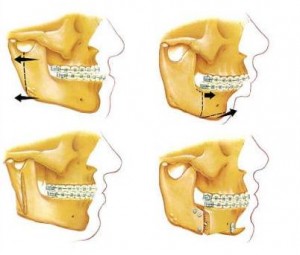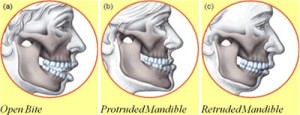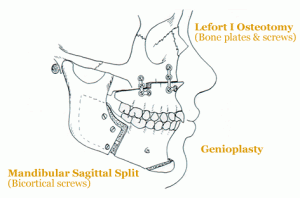Sometimes surgical procedures might be needed during orthodontic treatment when malocclusion is severe and beyond the limits of treatment with fixed dental braces. This orthodontic surgery procedure is called orthognathic surgery.
What is orthognathic surgery?
Orthognathic surgery derives from the two Greek words “ortho” means to straighten and “gnatic” means jaw. It is the correction of skeletal discrepancies that due to their severity lie outside the scope of orthodontics or also known as a cosmetic surgery in which jaws are straightened with the help of teeth braces. The procedure is usually deferred until active growth has slowed to adult levels.
Minor surgical procedures are sometimes carried out with orthodontics such as:
- Extractions – therapeutic and serial
- Surgical uncovering of impacted tooth
- Frenectomy
- Pericision or circumferential supracrestal fibrotomy
- Corticotomy
- Transplantation
Orthodontics with maxillofacial surgery is required when severity of malocclusion is beyond limits of treatment with fixed appliance and in severe skeletal malocclusion in absence of growth. There is an integrated approach for treatment planning with the oral surgeon. Patient cooperation and consent is very important as the procedure is normally performed under general anesthesia with comprehend risks involved.
Indications for orthognathic jaw surgery
- severe class II (retruded lower jaw) or class III (protruded lower jaw),
- vertical discrepancies such as severe deep bite and anterior open bite,
- skeletal asymmetry
Sequence of treatment
- Timing of jaw surgery – procedure is usually done after growth for stability except in craniofacial anomalies like cleft palate, Pierre Robin syndrome when it is done for improving function.
- Extraction of teeth (if necessary) – according to space discrepancy for aligning and leveling.
- Pre-surgical orthodontics is done to achieve desired anterior-posterior and vertical position of teeth by aligning and leveling, space closure unless used during surgery, and coordination of upper and lower arches.
- Pre-surgical orthodontics lasts for 12 to 18 months after which complete set of records are taken for model surgery and finalizing treatment plan.
- Surgery – performed under general anesthesia followed by intermaxillary fixation for 6 weeks but now with bone plates and screws followed by antibiotics and steroids, healing can be seen in 2 weeks.
- Post-surgical orthodontics – active tooth movement possible 4 weeks after surgery, final detailing of occlusion and root paralleling, intermaxillary elastics and round wires for inter digitations. If condyles are displaced during surgery, wrong occlusion can result but it may be corrected in the intermediate post surgical period.
- Retention with retainers or splint therapy.
Types of orthognathic surgical procedures
Sagittal procedures – upper jaw
- Le Fort I osteotomy – most widely used for upper jaw advancement or setback
- Le Fort II and Le Fort III osteotomy – usually only for mid face advancement or in craniofacial syndromes
Sagittal procedures – lower jaw
- Bilateral sagittal split osteotomy (BSSO) – lower jaw advancement and setback, may cause damage to inferior alveolar nerve, good control of condylar segment and most preferred approach
- Vertical subsigmoid osteotomy – usually only for lower jaw setback, less chance of neurosensory damage, condylar segment control is difficult
- Segmental body osteotomy – for lower jaw setback, rarely used now
Vertical procedures – upper jaw
- Le Fort I osteotomy
Vertical procedures – lower jaw
- Bilateral sagittal split osteotomy (BSSO)
- Subapical osteotomy – to reduce vertical height of body of lower jaw and chin
Transverse procedures
- Mid palatal osteotomy
- Genioplasty – wedge shape segment of bone at symphysis (chin) can be moved in all three planes
Bimaxillary surgery
When skeletal malocclusion is a combination of upper and lower jaw
Cosmetic surgical procedures
- Malar grafting
- Rhinoplasty
Distraction osteogenesis
Orthognathic surgical procedure for movement limited by soft tissue, in craniofacial syndromes with sever skeletal deformity as it is useful to achieve drastic extent of bone and soft tissue movement. Bone is fractured intentionally with segments under slow traction and tension. Callus and new bone formation at the osteotomised ends with corresponding soft tissue regeneration. This procedure is useful in growing children with severe deformity before orthognathic surgery.
Why relapse can happen
Relapse could be due to:
- Surgical factors – planning extent of movement, distraction of condyles, inadequate fixation
- Orthodontic factors – teeth not in equilibrium zone, extensive tooth movement
- Patent factors – severity of condition for example cleft lip and plate with scar tissue, persistent habits, poor compliance with treatment
How much would orthognathic surgery cost?
Orthognathic surgery cost can be a significant financial investment though most find it worthwhile. The surgery cost is very much expensive in its nature and varies place to place, country to country as well as nature of patient to patient. In the US, cost of orthognathic surgery ranges from $8,000 to $60,000. An accurate estimate would be difficult to provide since treatment costs vary depending on each individual and the problems they face.
Orthognathic surgery insurance may help reduce some financial burden but it differs from company to company. In the majority of cases, your insurance carrier should cover hospitalization, anesthesia and surgical fees, but may not cover the orthodontics required for successful treatment. Some may find that their dental insurance will cover a certain amount of the treatment. Orthodontics insurance rarely cover the entire treatment cost therefore it is advisable to know not only how much of the fee your benefit will cover but also if there is a maximum amount of benefit.



